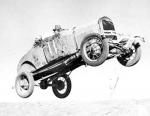|
|||||||
| Sponsored Links (Register now to hide all advertisements) |
|
|
 |

|
Thread Tools | Display Modes |
|
|
#21 | |
|
Senior Member
Join Date: May 2010
Location: Santee Calif.
Posts: 509
|
Quote:
|
|
|
|

|
|
|
#22 |
|
Senior Member
Join Date: May 2010
Location: Wa.
Posts: 5,409
|
If you knew the minimum weld that would hold the weight WITHOUT any bolts, you would be surprised.
|
|
|

|
| Sponsored Links (Register now to hide all advertisements) |
|
|
|
|
#23 | |
|
Senior Member
Join Date: Aug 2012
Location: Texas
Posts: 227
|
Quote:
Ed |
|
|
|

|
|
|
#24 | ||
|
Senior Member
Join Date: May 2010
Location: Eastern Tennessee
Posts: 11,519
|
Quote:
Pete, I am not sure I know the answer to this, but I am curious. Does the weight have greater forces that would cause it to want to separate from the crankshaft at 2,500 RPM vs 7,500 RPM? My instinct would say yes. If this is indeed true, I think this affects the method of how the mounting of the weights should be. Quote:
 ) and so my mindset was weld on all four sides, -and add more weld if I could find a place. Later I learned from multiple people that my additional welds did not make it any stronger. In my picture above, that was one of the first 20 or so that I did, but as I progressed and thought about it in detail, I came to realize I really was not gaining anything. ) and so my mindset was weld on all four sides, -and add more weld if I could find a place. Later I learned from multiple people that my additional welds did not make it any stronger. In my picture above, that was one of the first 20 or so that I did, but as I progressed and thought about it in detail, I came to realize I really was not gaining anything.
|
||
|
|

|
|
|
#25 |
|
Senior Member
Join Date: Jun 2015
Location: Red Deer, Alberta
Posts: 5,046
|
Take it to a place that does welder proficiency exams and have them inspect the welds.
__________________
If you don't hear a rumor by 10 AM, start one!. Got my education out behind the barn! |
|
|

|
|
|
#26 |
|
Senior Member
Join Date: Jan 2012
Location: Western North Carolina
Posts: 3,897
|
Sponsored Links (Register now to hide all advertisements)
In Brent's example above, the force at 7,500 rpm is 9 times what it is at 2,500 rpm. 3 squared = 9. The angular velocity can be calculated by multiplying the rpm by 2 pi radians per revolution and divided by 60 seconds/minute. The radius has to be in feet. The mass has to be in slugs, which is the weight in pounds divided by 32.2 feet/seconds squared (gravity). If you do the calculation, check the units. The result should be pounds force. The centrifugal force is only part of the story. There is vibration and acceleration to consider. A big factor of safety has to be added, say 3 times or more what is calculated. There will be a pop quiz on Monday.
__________________
A is for apple, green as the sky. Step on the gas, for tomorrow I die. Forget the brakes, they really don't work. The clutch always sticks, and starts with a jerk. My car grows red hair, and flies through the air. Driving's a blast, a blast from the past. Last edited by nkaminar; 03-22-2024 at 11:20 AM. |
|
|

|
|
|
#27 | |
|
Senior Member
Join Date: Aug 2012
Location: Texas
Posts: 227
|
Quote:
Ed |
|
|
|

|
|
|
#28 |
|
Senior Member
Join Date: May 2010
Location: Wa.
Posts: 5,409
|
The answer to the test question is:
At 48 million rpm, the .200 inch diameter steel ball bearing vaporized. It was levitated in a vacuum in a magnetic field and rotated by an RF signal applied to a fixed stator. In the case of the standard 3 main model B crankshaft, it had Dan Price full circle press on weights with 3, 1 inch diameter Mallory slugs pressed into each weight and the overall diameter of the crank reduced by 1 inch. After the weights were pressed on they were tig welded all around with ER70 rod. As much weight as possible was machined off the throw sides of the crank. It was final straightened and the journals were nitrided. This flathead 4 intake port engine turned 6500 twice a lap for one season of 6 vintage race events. It was not as smooth vibrationwise as a V8 but was far better than any stock crank model I ever saw. |
|
|

|
 |
«
Previous Thread
|
Next Thread
»
|
|
| Sponsored Links (Register now to hide all advertisements) |
|
|
All times are GMT -5. The time now is 06:32 AM.







 )
)

 Linear Mode
Linear Mode

